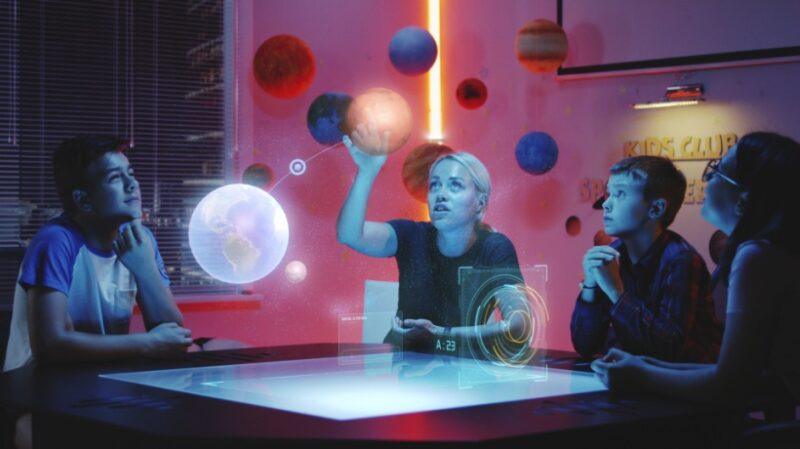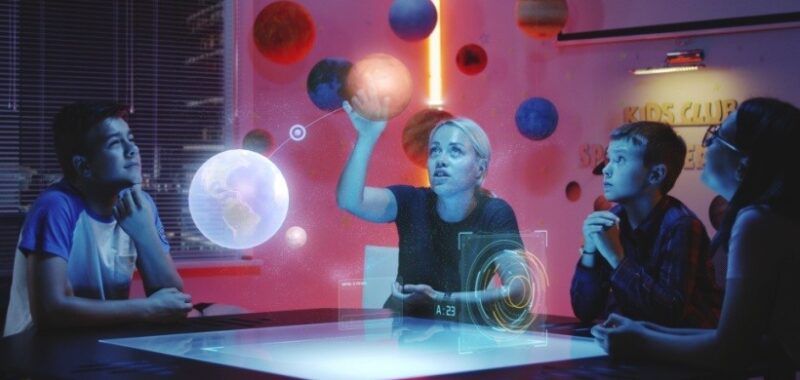
Augmented Reality In Education
Augmented Reality (AR) is rapidly transforming education by creating immersive learning environments that enhance students’ interactions with subjects. By overlaying digital content onto the real world, AR enriches lessons and fosters a deeper understanding of complex concepts. The integration of AR in education is proving to be a game changer, offering new ways to engage students, boost retention, and make learning more dynamic.
Key Benefits Of AR In Education
1. Enhanced Engagement
AR brings abstract concepts to life. For example, students learning about the solar system can visualize planets in 3D, interact with them, and understand their structure, positioning, and movement. This hands-on approach encourages curiosity and motivates students to explore topics further.
2. Improved Retention And Understanding
Studies have shown that visual and interactive content helps students retain information better than traditional text-based methods. With AR, learners can manipulate virtual objects, explore historical sites, or dissect digital models in ways that help reinforce knowledge and improve comprehension.
3. Personalized Learning
AR allows teachers to tailor learning experiences according to individual student needs. Whether it’s learners who need additional help or advanced students seeking more challenging content, AR enables a customized learning journey that accommodates different learning styles and paces.
4. Safe And Controlled Environment
In disciplines like chemistry or biology, students can conduct virtual experiments without the risk of injury or exposure to hazardous materials. AR simulations offer a safe environment where learners can explore, make mistakes, and learn from them without real-world consequences.
5. Collaboration And Interaction
AR fosters collaboration by allowing multiple students to interact with the same digital content simultaneously. In group projects, students can work together on AR-enabled activities that promote teamwork, communication, and problem-solving skills.
AR Applications In Education
1. Virtual Classrooms
Augmented Reality can transform classrooms into virtual learning spaces. Students can attend lectures, explore digital environments, and interact with 3D models, which enhance engagement and make lessons more interactive.
2. Gamified Learning
Gamification of education through AR is another rising trend. AR-based educational games make learning fun, encouraging students to solve puzzles, complete tasks, and participate in simulations that promote critical thinking and problem-solving skills.
3. Virtual Field Trips
AR allows students to take virtual field trips to historical landmarks, museums, or ecosystems, without leaving the classroom. This feature provides exposure to diverse environments and cultures, offering immersive experiences that traditional methods cannot replicate.
Challenges And Considerations
1. Cost Of Implementation
Although AR offers significant benefits, the cost of implementing AR technologies in schools can be high. Devices, applications, and training for teachers require investment, making it a challenge for underfunded schools.
2. Teacher Training
Teachers must be adequately trained to integrate AR into their lessons effectively. Professional development and resources are needed to ensure educators can leverage AR tools to enhance the learning experience rather than rely solely on traditional methods.
3. Accessibility
AR technology requires devices like smartphones, tablets, or AR glasses, which may not be accessible to all students. Ensuring equitable access to these tools is critical for widespread adoption.
Future Of AR In Education
The future of AR in education looks promising as technology continues to advance. With the rise of 5G networks and the development of more affordable AR tools, educational institutions are more likely to adopt AR on a larger scale. From interactive textbooks to virtual laboratories, the possibilities are endless for how AR can transform the education landscape.
Conclusion
Augmented Reality in education offers unparalleled opportunities to create engaging, interactive, and personalized learning experiences. By enhancing student engagement, improving retention, and fostering collaboration, AR has the potential to revolutionize the way we teach and learn. As technology becomes more accessible, we can expect AR to play an even bigger role in shaping the future of education.
FAQs
- What is Augmented Reality in education?
Augmented Reality in education is a technology that overlays digital content, such as images, videos, or 3D models, onto the real world using devices like smartphones, tablets, or AR glasses. This enhances the learning experience by making subjects more interactive, engaging, and easier to understand through immersive visuals and simulations. - How does AR improve student engagement in the classroom?
AR improves engagement by making lessons interactive and visually appealing. Students can interact with 3D models, explore virtual environments, and participate in simulations that bring abstract concepts to life. This immersive approach encourages active participation and helps students stay focused and interested in the subject matter. - What are some examples of how AR is used in education?
AR can be used for virtual field trips, where students explore historical sites or natural environments without leaving the classroom. It’s also used in science classes to simulate experiments, in anatomy classes to explore the human body in 3D, and in gamified learning to make subjects like math and language more interactive and fun. - What are the challenges of implementing AR in schools?
The main challenges include the cost of AR devices and applications, the need for teacher training to effectively integrate AR into lessons, and ensuring equal access to technology for all students. Schools must also invest in infrastructure, such as compatible devices and reliable internet connections, to support AR technologies. - What is the future of AR in education?
The future of AR in education is promising as technology advances and becomes more affordable. AR could become a standard tool for creating personalized, immersive learning experiences. With the rise of 5G and more affordable AR solutions, schools may adopt this technology on a larger scale, transforming classrooms into dynamic, interactive learning environments.

